Introduction-
Dhamma sadhu, kiyam cu dhammeti? Apasinave, bahukayane, daya, dane, sace, socaye.
Dhamma is good, but what constitutes Dhamma? (It includes) little evil, much good, kindness, generosity, truthfulness and purity.
With the rediscovery and translation of Indian literature by European scholars in the 19th century, it was not just the religion and philosophy of Buddhism that came to light, but also its many legendary histories and biographies. Amongst this class of literature, one name that came to be noticed was that of Asoka, a good king who was supposed to have ruled India in the distant past. Stories about this king, similar in outline but differing greatly in details, were found in the Divyavadana, the Asokavadana, the Mahavamsa and several other works. They told of an exceptionally cruel and ruthless prince who had many of his brothers killed in order to seize the throne, who was dramatically converted to Buddhism and who ruled wisely and justly for the rest of his life.
But in 1837, James Prinsep succeeded in deciphering an ancient inscription on a large stone pillar in Delhi. Several other pillars and rocks with similar inscriptions had been known for some time and had attracted the curiosity of scholars. Prinsep's inscription proved to be a series of edicts issued by a king calling himself "Beloved-of-the-Gods, King Piyadasi." In the following decades, more and more edicts by this same king were discovered and with increasingly accurate decipherment of their language, a more complete picture of this man and his deeds began to emerge. Gradually, it dawned on scholars that the King Piyadasi of the edicts might be the King Asoka so often praised in Buddhist legends. However, it was not until 1915, when another edict actually mentioning the name Asoka was discovered, that the identification was confirmed. Having been forgotten for nearly 700 years, one of the greatest men in history became known to the world once again.
King Asoka-
His given name was Asoka but he assumed the title Devanampiya Piyadasi which means "Beloved-of-the-Gods, He Who Looks On With Affection." There seems to have been a two-year war of succession during which at least one of Asoka's brothers was killed. In 262 B.C., eight years after his coronation, Asoka's armies attacked and conquered Kalinga, a country that roughly corresponds to the modern state of Orissa. The loss of life caused by battle, reprisals, deportations and the turmoil that always exists in the aftermath of war so horrified Asoka that it brought about a complete change in his personality. It seems that Asoka had been calling himself a Buddhist for at least two years prior to the Kalinga war, but his commitment to Buddhism was only lukewarm and perhaps had a political motive behind it. But after the war Asoka dedicated the rest of his life trying to apply Buddhist principles to the administration of his vast empire. He had a crucial part to play in helping Buddhism to spread both throughout India and abroad and probably built the first major Buddhist monuments. Asoka died in 232 B.C. in the thirty-eighth year of his reign.
Measures taken by Asoka to spread Buddhism-
It is also very clear that Buddhism was the most influential force in Asoka's life and that he hoped his subjects likewise would adopt his religion. He went on pilgrimages to Lumbini and Bodh Gaya, sent teaching monks to various regions in India and beyond its borders, and he was familiar enough with the sacred texts to recommend some of them to the monastic community. It is also very clear that Asoka saw the reforms he instituted as being a part of his duties as a Buddhist. But, while he was an enthusiastic Buddhist, he was not partisan towards his own religion or intolerant of other religions.
Scholars have suggested that because the edicts say nothing about the philosophical aspects of Buddhism, Asoka had a simplistic and naive understanding of the Dhamma. This view does not take into account the fact that the purpose of the edicts was not to expound the truths of Buddhism, but to inform the people of Asoka's reforms and to encourage them to be more generous, kind and moral.
Society during Asoka-
The contents of Asoka's edicts make it clear that all the legends about his wise and humane rule are more than justified and qualify him to be ranked as one of the greatest rulers. The first was what he based his administration upon and what he hoped would lead to a more just, more spiritually inclined society, while the second was what he recommended and encouraged individuals to practice. Both these types of morality were imbued with the Buddhist values of compassion, moderation, tolerance and respect for all life The judicial system was reformed in order to make it more fair, less harsh and less open to abuse. State resources were used for useful public works. To ensure that these reforms and projects were carried out, Asoka made himself more accessible to his subjects by going on frequent inspection tours and he expected his district officers to follow his example. Hunting certain species of wild animals was banned, forest and wildlife reserves were established and cruelty to domestic and wild animals was prohibited. The protection of all religions, their promotion and the fostering of harmony between them, was also seen as one of the duties of the state. It even seems that something like a Department of Religious Affairs was established with officers called Dhamma Mahamatras whose job it was to look after the affairs of various religious bodies and to encourage the practice of religion.
The individual morality that Asoka hoped to foster included respect (susrusa) towards parents, elders, teachers, friends, servants, ascetics and brahmans — behavior that accords with the advice given to Sigala by the Buddha (DighaNikaya, Discourse No. 31). He encouraged generosity (dana) to the poor (kapanavalaka), to ascetics and brahmans, and to friends and relatives. Not surprisingly, Asoka encouraged harmlessness towards all life (avihisabhutanam). In conformity with the Buddha's advice in the AnguttaraNikaya, II:282, he also considered moderation in spending and moderation in saving to be good (apavyayataapabhadata). The qualities of heart that are recommended by Asoka in the edicts indicate his deep spirituality. They include kindness (daya), self-examination (palikhaya), truthfulness (sace), gratitude (katamnata), purity of heart (bhavasudhi), enthusiasm (usahena), strong loyalty (dadhabhatita), self-control (sayame) and love of the Dhamma (Dhammakamata).
We have no way of knowing how effective Asoka's reforms were or how long they lasted but we do know that monarchs throughout the ancient Buddhist world were encouraged to look to his style of government as an ideal to be followed. King Asoka has to be credited with the first attempt to develop a Buddhist polity. Today, with widespread disillusionment in prevailing ideologies and the search for a political philosophy that goes beyond greed (capitalism), hatred (communism) and delusion (dictatorships led by "infallible" leaders), Asoka's edicts may make a meaningful contribution to the development of a more spiritually based political system.
Edicts of Asoka-
Asoka's edicts are to be found scattered in more than thirty places throughout India, Nepal, Pakistan and Afghanistan. Most of them are written in Brahmi script from which all Indian scripts and many of those used in Southeast Asia later developed. The language used in the edicts found in the eastern part of the sub-continent is a type of Magadhi, probably the official language of Asoka's court. The language used in the edicts found in the western part of India is closer to Sanskrit although one bilingual edict in Afghanistan is written in Aramaic and Greek. These pillars in particular are testimony to the technological and artistic genius of ancient Indian civilization. Originally, there must have been many of them, although only ten with inscriptions still survive. Averaging between forty and fifty feet in height, and weighing up to fifty tons each, all the pillars were quarried at Chunar, just south of Varanasi and dragged, sometimes hundreds of miles, to where they were erected. Each pillar was originally capped by a capital, sometimes a roaring lion, a noble bull or a spirited horse, and the few capitals that survive are widely recognized as masterpieces of Indian art. Both the pillars and the capitals exhibit a remarkable mirror-like polish that has survived despite centuries of exposure to the elements. Some, like the Lumbini pillar, mark the Buddha's birthplace, while its inscriptions commemorate Asoka's pilgrimage to that place. Others are to be found in or near important population centers so that their edicts could be read by as many people as possible.
There is little doubt that Asoka's edicts were written in his own words rather than in the stylistic language in which royal edicts or proclamations in the ancient world were usually written in. Asoka's style tends to be somewhat repetitious and plodding as if explaining something to one who has difficulty in understanding. Asoka frequently refers to the good works he has done, although not in a boastful way, but more, it seems, to convince the reader of his sincerity. Asoka tells his subjects that he looked upon them as his children, that their welfare is his main concern; he apologizes for the Kalinga war and reassures the people beyond the borders of his empire that he has no expansionist intentions towards them.
The Edicts of Asoka are a collection of 33 inscriptions on the Pillars of Asoka as well as boulders and cave walls made by the Emperor Asoka of the Mauryan Empire during his reign from 269 BCE to 232 BCE. These inscriptions were dispersed throughout the areas of modern-day Bangladesh, India, Nepal, Afghanistan and Pakistan and represent the first tangible evidence of Buddhism. The edicts describe in detail the Asoka’s view about dhamma, an earnest attempt to solve some of problems that a complex society faced. According to the edicts, the extent of Buddhist proselytism during this period reached as far as the Mediterranean, and many Buddhist monuments were created. The Edicts are divided into:
- Pillar Edicts
- Major Rock Edicts: 14 Edicts (termed 1st to 14th) and 2 separate ones found in Odisha
- Major Rock Inscriptions: Minor Rock Edicts, the Queen's Edict, Barabar Caves inscriptions and the Kandahar bilingual inscription.
These inscriptions proclaim Asoka’s adherence to the Buddhist philosophy which, as in Hinduism is called dharma, "Law". The inscriptions show his efforts to develop the Buddhist dharma throughout his kingdom. Although Buddhism and the Gautama Buddha are mentioned, the edicts focus on social and moral precepts rather than specific religious practices or the philosophical dimension of Buddhism. These were located in public places and were meant for people to read.
In these inscriptions, Asoka refers to himself as "Beloved servant of the Gods" (Devanampiyadasi) The identification of Devanampiyadasi with Asoka was confirmed by an inscription discovered in 1915 by C. Beadon, a British gold-mining engineer, at Maski, a village in Raichur district of Karnataka. Another minor rock edict is found at the village Gujarra in Datia district of Madhya Pradesh. This also shows the name "Asoka" in addition to usual "Devanampiyadasi". The inscriptions found in the eastern part of India were written in Magadhi Prakrit using the Brahmi script. These edicts were deciphered by British archaeologist and historian James Prinsep.
The inscriptions revolve around a few recurring themes: Asoka’s conversion to Buddhism, the description of his efforts to spread Buddhism, his moral and religious precepts, and his social and animal welfare program. The edicts were based on Asoka’s ideas on administration and behaviour of people towards one another and religion.
Map of Asoka’s Rock Edicts in India-
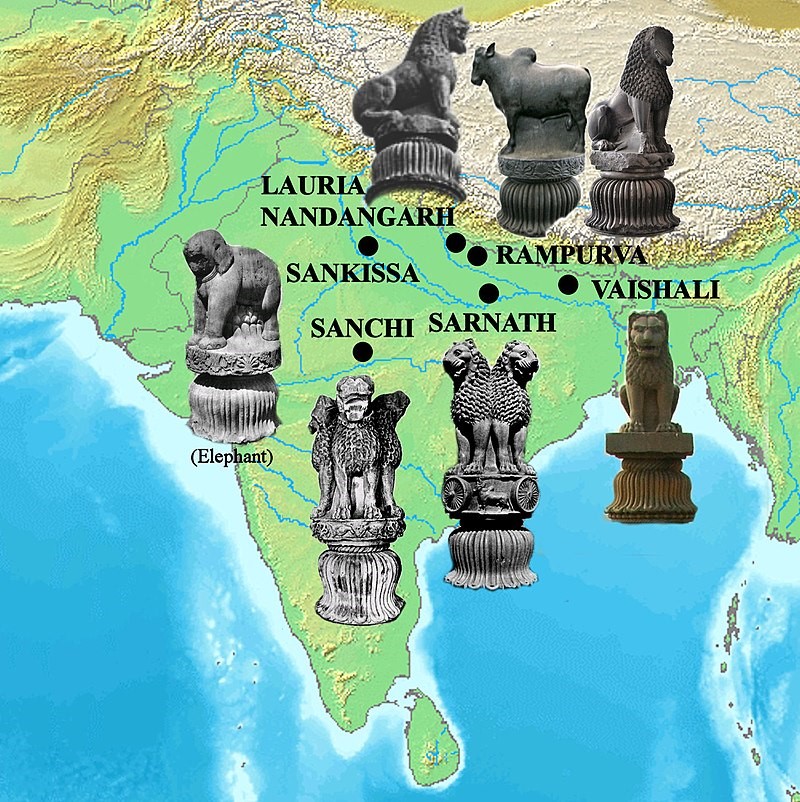
Geographical distribution of known capitals of the Pillars of Asoka. These are all thought to have been commissioned by Asoka
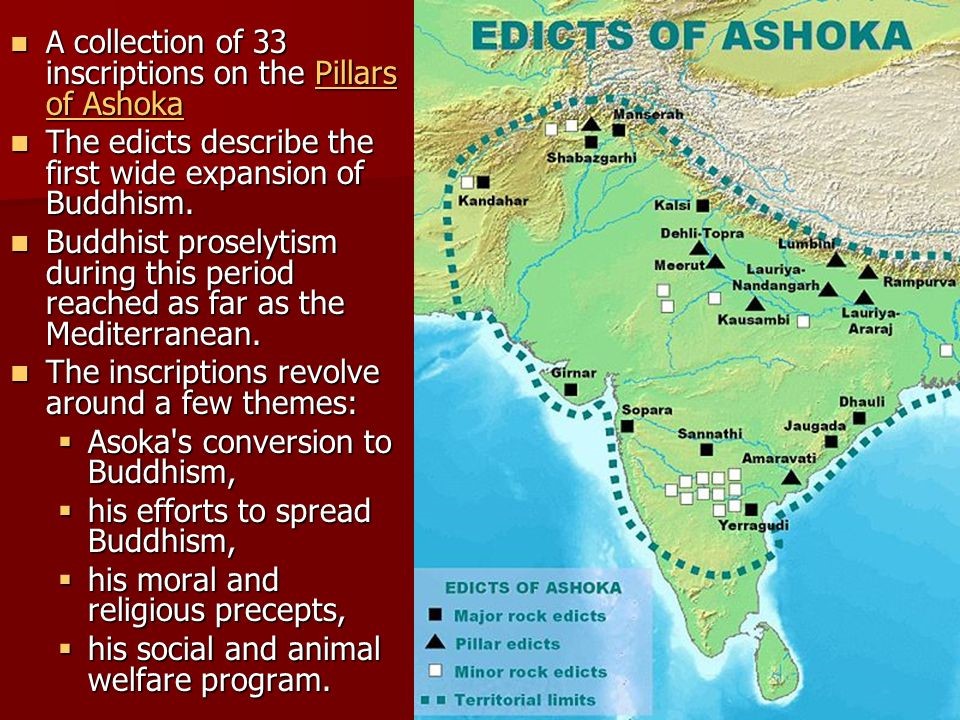
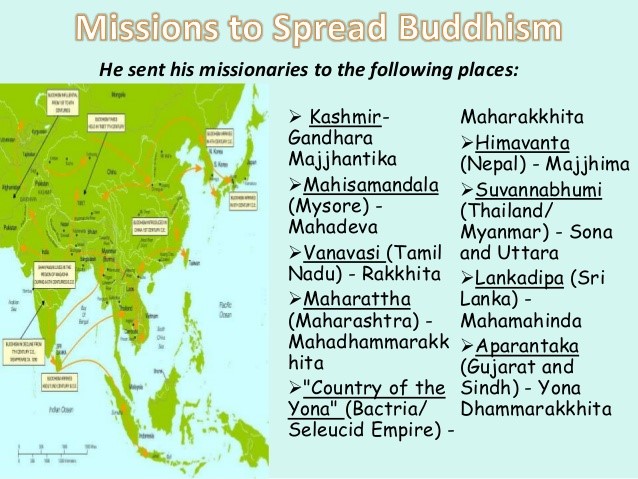
Stupa-
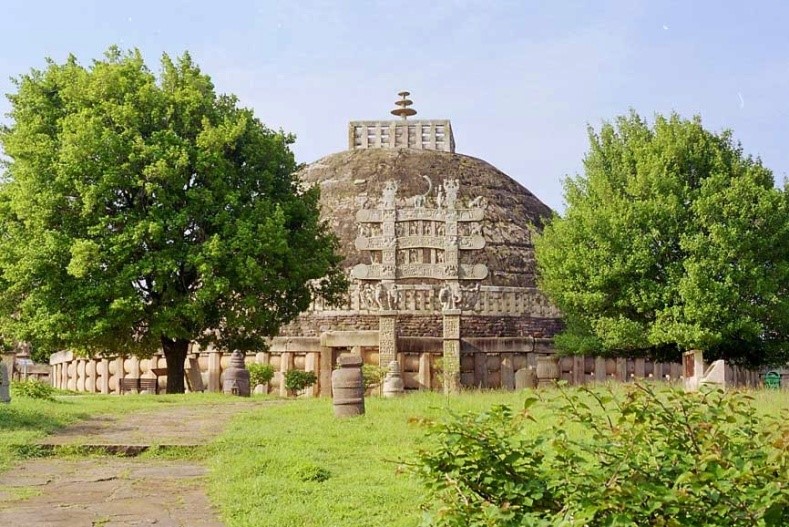
Stupa of Sanchi. The central stupa was built during the Mauryas, and enlarged during the Sungas, but the decorative gateway is dated to the later dynasty of the Satavahanas.
Asoka also invited Buddhists and non-Buddhists for religious conferences. He inspired the Buddhist monks to compose the sacred religious texts, and also gave all types of help to that end. Asoka also helped to develop viharas (intellectual hubs) such as Nalanda and Taxila. Asoka helped to construct Sanchi and Mahabodhi Temple. Asoka also gave donations to non-Buddhists. As his reign continued his even-handedness was replaced with special inclination towards Buddhism.[62] Asoka helped and respected both Shramanas (Buddhists monks) and Brahmins (Vedic monks). Asoka also helped to organise the Third Buddhist council (c. 250 BCE) at Pataliputra (today's Patna). It was conducted by the monk Moggaliputta-Tissa who was the spiritual teacher of Asoka.
Asoka’s proselytism-
In order to propagate the Buddhist faith, Asoka explains that he sent emissaries to the Hellenistic kings as far as the Mediterranean, and to people throughout India, claiming they were all converted to the Dharma as a result. He names the Greek rulers of the time, inheritors of the conquest of Alexander the Great, from Bactria to as far as Greece and North Africa, displaying a clear grasp of the political situation at the time.
Proselytism beyond India-

Buddhist proselytism at the time of king Asoka (260–218 BCE).
Now it is conquest by Dhamma that Beloved-Servant-of-the-God considers to be the best conquest. And it [conquest by Dhamma] has been won here, on the borders, even six hundred yojanas away, where the Greek king Antiochos rules, beyond there where the four kings named Ptolemy, Antigonos, Magas and Alexander rule, likewise in the south among the Cholas, the Pandyas, and as far as Tamraparni. Rock Edict Nb13 (S. Dhammika)
The distance of 600 yojanas corresponds to the distance between the center of India and Greece, roughly 4,000 miles.
- Amtiyoko refers to Antiochus II Theos of Syria (261–246 BCE), who controlled the Seleucid Empire from Syria to Bactria in the east from 305 to 250 BCE, and was therefore a direct neighbor of Asoka.
- Turamaye refers to Ptolemy II Philadelphos of Egypt (285–247 BCE), king of the dynasty founded by Ptolemy I, a former general of Alexander the Great, in Egypt.
- Amtikini refers to Antigonus II Gonatas of Macedon (278–239 BCE).
- Maka refers to Magas of Cyrene (300–258 BCE).
- Alikasudaro refers to Alexander II of Epirus (272–258 BCE).

The Khalsi rock edict of Asoka, which mentions the Greek kings Antiochus, Ptolemy, Antigonus, Magasand Alexander by name (underlined in colour)
In the Gandhari original Antiochos is referred to as "Amtiyoko nama Yona-raja" (lit. "The Greek king by the name of Antiokos"), beyond whom live the four other kings: "param ca tena Atiyokena cature 4 rajani Turamaye nama Amtikini nama Maka nama Alikasudaro nama" (lit. "And beyond Antiochus, four kings by the name of Ptolemy, the name of Antigonos, the name of Magas, the name Alexander"
It is not clear in Hellenic records whether these emissaries were actually received, or had any influence on the Hellenic world. Some scholars, however, point to the presence of Buddhist communities in the Hellenistic world from that time, in particular in Alexandria (mentioned by Clement of Alexandria). The pre-Christian monastic order of the Therapeutae may have drawn inspiration for its ascetic lifestyle from contact with Buddhist monasticism, although the foundation and Scriptures were Jewish.A possible Buddhist gravestone from the Ptolemaic period has been found by Flinders Petrie, decorated with a depiction of what may be Wheel of the Law and Trishula. Commenting on the presence of Buddhists in Alexandria, Robert Linssen pointed out that "It was later in this very place that one of the most active centres of Christianity was established".
The philosopher Hegesias of Cyrene, from the city of Cyrene where Magas ruled in Cyrenaica, is sometimes thought to have been influenced by the teachings of Asoka’s Buddhist missionaries, given the similarity of some of his teachings with Buddhism.
Proselytism within Asoka’s territories-
Inside India proper, in the realm of Asoka, many different populations were the object of the King’s proselytism:
Here in the king's domain among the Greeks, the Kambojas, the Nabhakas, the Nabhapamkits, the Bhojas, the Pitinikas, the Andhras and the Palidas, everywhere people are following Beloved-Servant-of-the-Gods' instructions in Dhamma. Rock Edict Nb13 (S. Dhammika)
Greek communities-
Greek communities lived in the northwest of the Mauryan Empire, currently in Pakistan, notably ancient Gandhara, and in the region of Gedrosia, nowadays in Southern Afghanistan, following the conquest and the colonization efforts of Alexander the Great around 323 BCE. These communities therefore seem to have been still significant during the reign of Asoka. A notable mention references aspects of Greek society.
There is no country, except among the Greeks, where these two groups, Brahmans and ascetics, are not found, and there is no country where people are not devoted to one or another religion. Rock Edict Nb13 (S. Dhammika)
Two edicts in Afghanistan have been found with Greek inscriptions, one of these being a bilingual edict in Greek language and Aramaic. This edict, found in Kandahar, advocates the adoption of "Piety" (using the Greek term Eusebeia for Dharma) to the Greek community:
Ten years (of reign) having been completed, King
Piodasses (one of the titles of Asoka: Piyadassi or Priyadarsi, "He who is the beloved servant of the Gods and who regards
everyone amiably") made known (the doctrine of)
Piety (Greek:εὐσέβεια, Eusebeia) to men; and from this moment he has made men more pious, and everything thrives throughout the whole world. And the king abstains from (killing) livingbeings,another men and those who (are) huntsmen and fishermen of the king have desisted from hunting. And if some (were) intemperate, they have ceased from their intemperance as was in their power; and obedient to their father and mother and to the elders, in opposition to the past also in the future, by so acting on every occasion, they will live better and more happily. (Trans. by G. P. Carratelli).
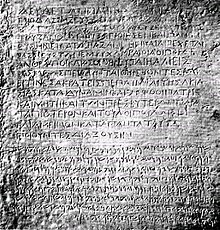
The Kandahar Edict of Asoka, a bilingual inscription (Greek and Aramaic) by king Asoka, from Kandahar. Kabul Museum.
Other communities-
- Kambojas are a people of Central Asian origin who had settled first in Arachosia and Drangiana (today’s southern Afghanistan), and in some of the other areas in the northwestern Indian subcontinent in Sindhu, Gujarat and Sauvira.
- The Nabhakas, the Nabhapamkits, the Bhojas, the Pitinikas, the Andhras and the Palidas are other people under Asoka’s rule.
Conclusion-
The tragedy of Kalinga and Asoka’s response to warfare was his inspiration for the formulation of the concept of dhamma. Dhamma derives from the concept, originally set down by Hinduism of dhamma (duty) which is one’s responsibility or purpose in life but, more directly, from Buddha’s use of dharma as cosmic law and that which should be heeded. Asoka’s dhamma includes this understanding but expands it to mean general goodwill and beneficence to all as “right behaviour” which promotes peace and understanding. Asoka embarked on pilgrimages sites sacred to Buddha and began to disseminate his thoughts on dramas after he had embraced Buddhism. He ordered edicts, many referencing, dhamma or explaining the concept fully, engraved in stone throughout his empire and sent Buddhist missionaries to other regions and nations including modern-day Sri Lanka, China, Thailand, and Greece; in so doing, he established Buddhism as a major world religion. These missionaries spread Buddha's vision peacefully since, as Asoka had decreed, no one should elevate their own religion over anyone else's; to do so devalued one's own faith by supposing it to be better than another's and so lost the humility necessary in approaching sacred subjects. Buddha's remains, before Asoka’s reign, had been placed in eight stupas (tumuli containing relics) around the country. Asoka had the relics removed and is said to have decreed the construction of 84,000 stupas throughout the country, each to have some part of the Buddha's remains inside. In this way, he thought, the Buddhist message of peace and harmonious existence between people and the natural world would be encouraged further. The number of these stupas is considered an exaggeration but there is no doubt that Asoka did order construction of a number of them, such as the famous work at Sanchi.
After reigning for nearly 40 years, Asoka died. His reign had enlarged and strengthened the Mauryan Empire and yet it would not endure for even 50 years after his death. His name was eventually forgotten, his stupas became overgrown, and his edicts, carved on majestic pillars, toppled and buried by the sands. When European scholars began exploring Indian history in the 19th century, the British scholar and orientalist James Prinsep came across an inscription on the Sanchi stupa in an unknown script which, eventually, he came to understand as referencing a king by the name of Devanampiya Piyadassi who, as far as Prinsep knew, was referenced nowhere else.
In time, and through the efforts of Prinsep in deciphering Brahmi Script as well as those of other scholars, it was understood that the Asoka named as a Mauryan king in the Puranas was the same as this Devanampiya Piyadassi. Prinsep published his work on Asoka in 1837 CE, shortly before he died, and the great Mauryan king has since attracted increasing interest around the world; most notably as the only empire-builder of the ancient world who, at the height of his power, renounced warfare and conquest to pursue mutual understanding and harmonious existence as both domestic and foreign policy.
Bibliography-
- https://en.wikipedia.org/wiki/Ashoka
- https://en.wikipedia.org/wiki/Edicts_of_Ashoka
- https://www.accesstoinsight.org/lib/author
